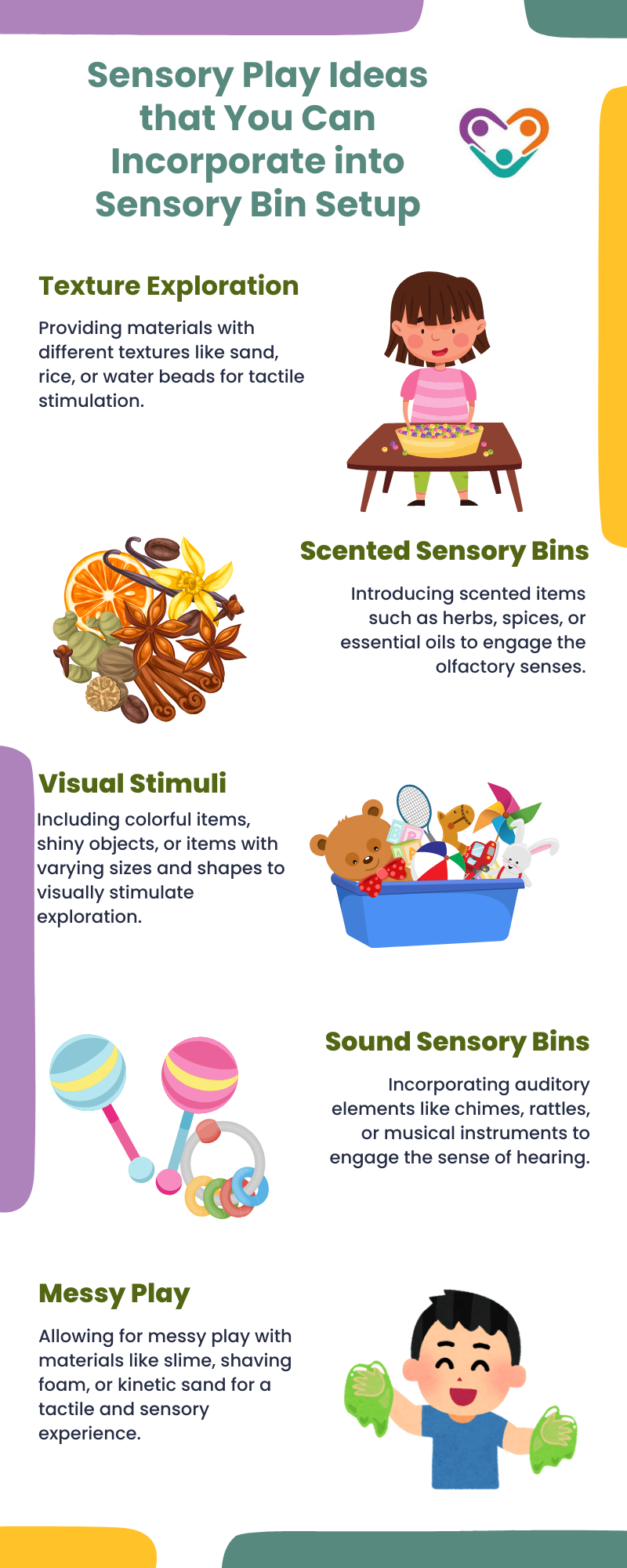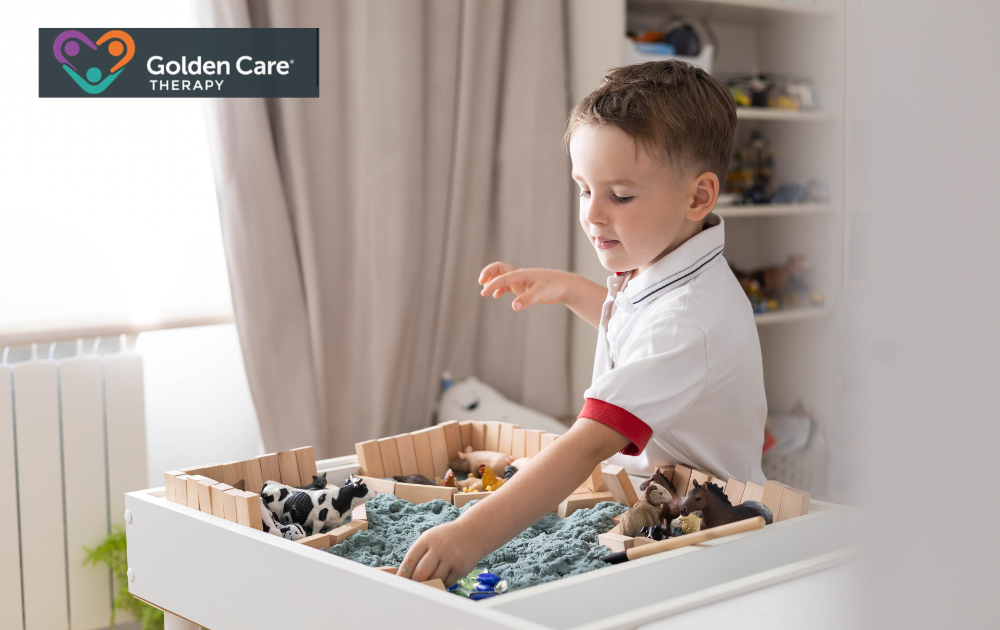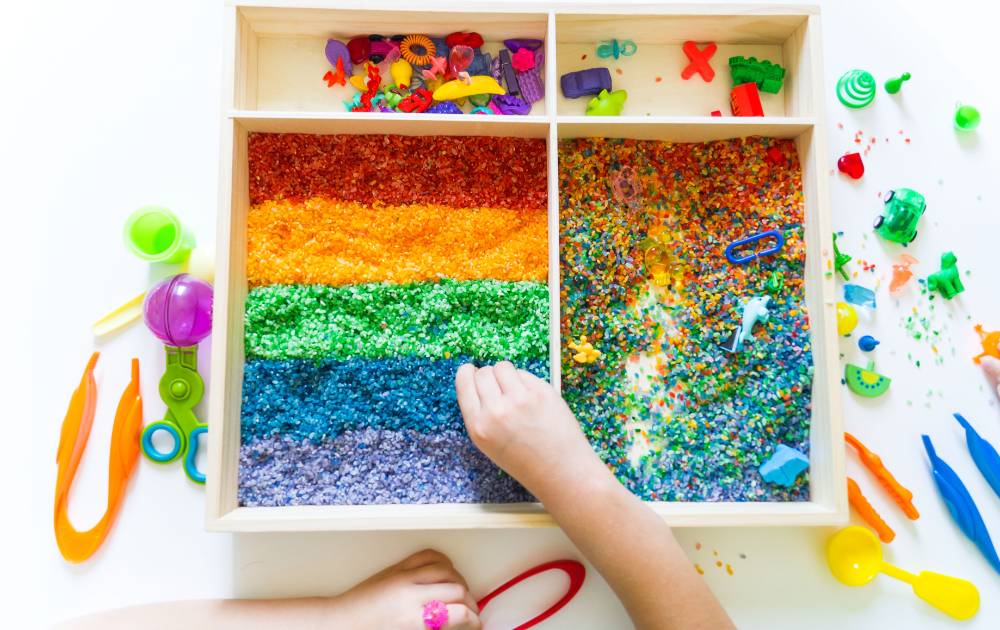Sensory bins are magical spaces filled with textures, colors, and materials that invite exploration and play. For children on the autism spectrum, these bins offer more than just fun; they provide a unique way to learn, express themselves, and connect with the world around them.
Engaging their senses through various activities helps them discover new skills, improve their attention span, and find comfort in familiar routines. Whether it’s scooping, pouring, or creating, sensory bins encourage creativity and sensory exploration, making them an invaluable tool for parents, educators, and therapists.
Exploring the role of sensory bins reveals how they can support the growth and development of children with autism in delightful and impactful ways.
What are Sensory Bins?
Sensory bins are containers filled with various materials that stimulate the senses, such as touch, sight, sound, and sometimes even smell. These bins are designed to encourage sensory exploration and provide a hands-on sensory experience.
Individuals are encouraged to interact with the materials in the bin, promoting sensory engagement and learning through play.
Sensory bins often incorporate a mix of textures, colors, shapes, and objects that cater to different sensory preferences. By engaging with the materials in the bin, individuals with autism can explore and process sensory information in a controlled and enjoyable environment.
That said, sensory bins play a significant role in supporting individuals with autism in managing sensory input and promoting overall well-being. For individuals with autism, sensory processing issues can lead to challenges in regulating their responses to sensory stimuli from the environment.
Sensory bins provide a safe and structured way for individuals to engage with sensory input at their own pace.
With sensory bins, autistic individuals can experience sensory stimuli in a controlled setting, helping them regulate their sensory responses and develop coping mechanisms.
Their hands-on nature also promotes fine motor skills, cognitive development, and emotional regulation.
The structured nature of sensory bins allows individuals with autism to explore different sensory elements in a predictable and organized manner. This predictability can create a sense of comfort and security, reducing anxiety and promoting relaxation.
Additionally, sensory bins can be tailored to individual preferences and sensory profiles, making them a versatile tool for sensory exploration and learning for individuals on the autism spectrum.
How to Create Effective Sensory Bin Setups
To set up sensory bins for individuals with autism, it’s essential to consider specific factors that can enhance the sensory experience and cater to the unique needs of each individual.
Additionally, choosing the right sensory bin materials plays a crucial role in creating a safe and engaging sensory environment. When designing sensory bin setups for individuals with autism, it’s important to take into account their sensory preferences and sensitivities.
Each individual may respond differently to various sensory stimuli, so it’s vital to customize the setup based on their specific needs.
As such, you have to consider the following factors when creating sensory bin setups for individuals with autism:
- Sensory Preferences: Take into consideration whether the individual is sensitive to certain textures, sounds, or visual stimuli. Tailor the sensory bin materials to align with their preferences and provide a comfortable sensory experience.
- Safety Concerns: Ensure that the sensory bin setup is free from any small objects that could pose a choking hazard. Select materials that are non-toxic and safe for exploration.
- Personal Space: Some individuals with autism may prefer a quieter and more controlled sensory environment. Create a designated space for the sensory bin that allows the individual to engage with the materials at their own pace.
Also, choosing the right sensory bin materials is key to creating an effective and stimulating sensory experience for individuals with autism. The materials chosen should offer a range of sensory input while being safe and appealing to the individual.
Consider incorporating a variety of materials with different textures, colors, and shapes to cater to diverse sensory preferences. Some commonly used sensory bin materials include rice, beans, sand, water beads, and feathers.
Activities and Benefits of Sensory Bins
Engaging individuals with autism in sensory play can have a profound impact on their development and well-being. Here, we explore various sensory play ideas tailored for individuals with autism, along with the cognitive and emotional benefits associated with sensory bin activities.
Sensory Play Ideas
Sensory bins offer a wide range of play opportunities that cater to the unique sensory needs of individuals with autism. Here are some sensory play ideas that can be incorporated into sensory bin setups:

These sensory play ideas can be customized based on individual preferences and sensitivities, providing a safe and enjoyable sensory experience for individuals with autism.
On another note, engaging in sensory bin activities can yield a multitude of cognitive and emotional benefits for individuals with autism. Some of the key advantages include sensory regulation, sensory awareness, language development, emotional expression, and stress reduction.
With sensory bin activities integrated into daily routines, caregivers and individuals with autism can harness these cognitive and emotional benefits to enhance sensory processing, promote self-regulation, and nurture overall well-being.
Tips for Engaging with Sensory Bins
To successfully engage with sensory bins for autistic individuals, guided interaction strategies and promoting sensory exploration are key.
Guided interaction strategies involve providing gentle support and direction to individuals with autism as they engage with sensory bins. This can include:
- Modeling Behavior: Demonstrate how to interact with the sensory bin by engaging in the activity yourself. This can help individuals with autism understand how to explore the materials.
- Verbal Encouragement: Offer positive reinforcement and praise as the individual explores the sensory bin. Encouraging words can help build confidence and foster a sense of accomplishment.
- Visual Supports: Use visual aids such as pictorial instructions or visual schedules to guide the individual through the sensory play activity. Visual supports can enhance understanding and communication.
Also, promoting sensory exploration involves creating an environment that encourages individuals with autism to engage with their senses safely and positively. This can be achieved through:
- Variety of Textures: Include a diverse range of textures in the sensory bin, such as smooth, rough, soft, and hard materials. This provides sensory stimulation and encourages tactile exploration.
- Multi-Sensory Elements: Incorporate elements that engage multiple senses, such as scented materials, auditory stimuli (like calming music), and visually appealing colors. A multi-sensory approach can enhance the overall sensory experience.
- Individual Preferences: Consider the individual’s sensory preferences and aversions when setting up the sensory bin. Tailoring the materials to suit their preferences can increase engagement and comfort.

Final Thoughts
Sensory bins are a fantastic tool for supporting children with autism. They provide a fun and engaging way for kids to explore different textures, colors, and shapes, helping them develop important skills like focus, communication, and creativity.
So, let’s embrace the power of sensory bins and unlock a world of possibilities for our children, encouraging them to express themselves and thrive in their unique way! At Golden Care Therapy, we are dedicated to providing top-notch ABA therapy in Indiana that truly makes a difference.
If you’re ready to learn more about how we can support your child, contact us today! We look forward to partnering with you on this journey.
Sources:



